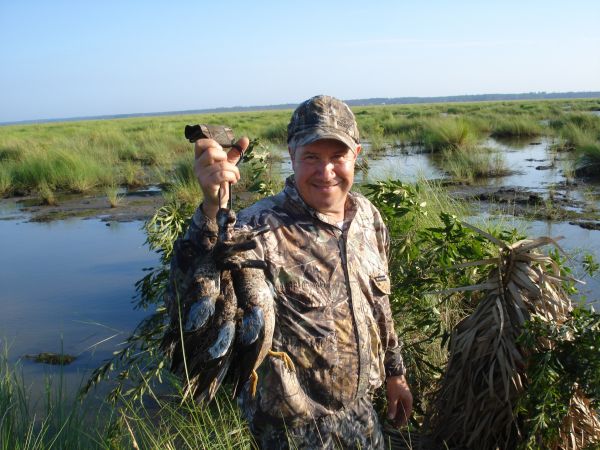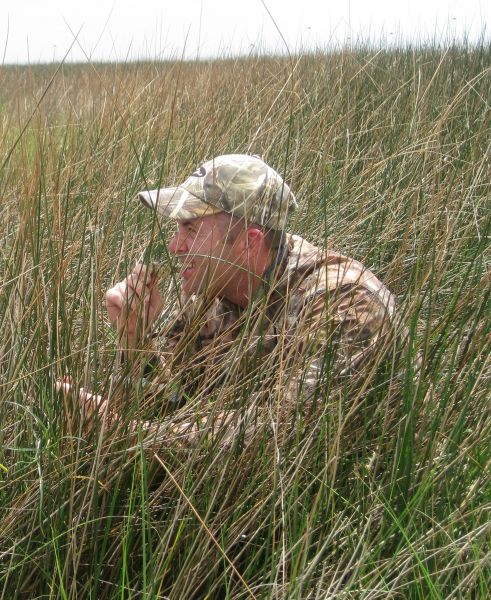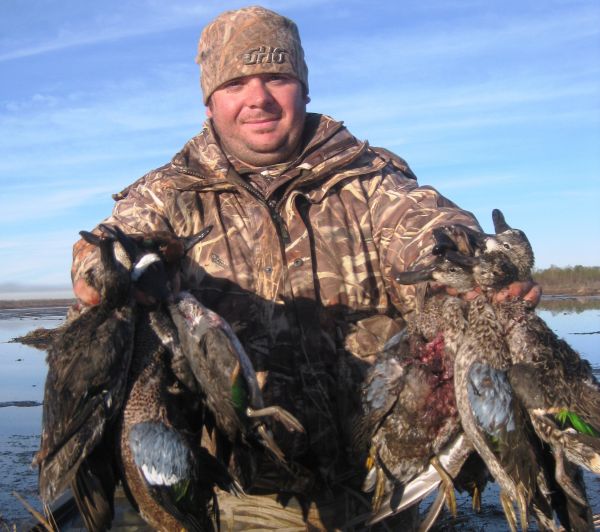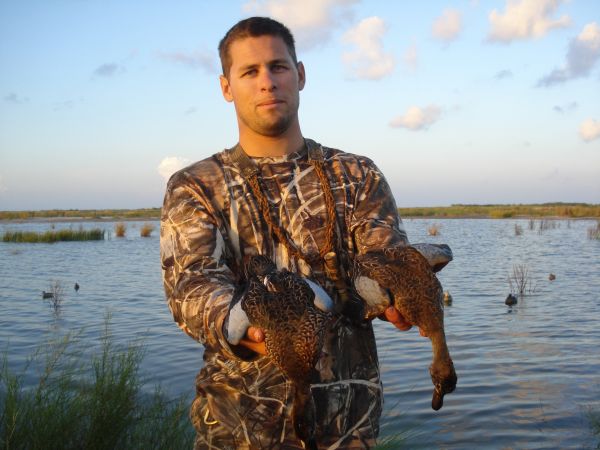Understanding what makes a blue-winged teal tick can help you catch up to the acrobatic flyer during the early 16-day season.
Ask a Louisiana duck hunter to describe a good hunting experience and you’re most likely to get a story that reflects upon a time when he and his comrades ventured into the swamp to bag a limit of big ducks in the wintry months of November through January.
When it comes to looking back on the accomplishments of the seasons that have passed, it is only natural to immediately consider that time frame.
After all, it’s when most of the hunting happens; it’s when the ducks are prettier, fatter and most plentiful; it’s more than likely the reason why most duck hunters still have meat in their freezers from the previous year, and there’s a 99.9-percent chance that it represents the time when a hunter bagged the beautiful duck that is mounted on their office wall to this day.
As the great ambassadors of the hobby we love, it would be an injustice to an aspiring hunter if we were to tell them anything less than our greatest duck-hunting story in hopes of making them curious enough to want to jump in the boat with us on our next excursion.
But even though telling the tales of the big duck season are what typically come to mind, a true hunter would be remiss if somewhere in there a good teal hunting memory wasn’t on his list to share.
With the 2012 teal season swooping in upon us just as swiftly as the birds it allows us to hunt, Louisiana Sportsman caught up with two local duck-hunting aficionados who believe that with the right tactics and understanding, teal hunting can provide just as memorable of an experience as the big ducks — but if you blink you just might miss it.
“The best word to describe them is quick. They’re not necessarily faster than big ducks, but they have agile, erratic flight patterns that make them sometimes harder to hit,” said Neil Gauthier, an environmental biology graduate from Southeastern Louisiana University who studies the behaviors of the birds that migrate to our area to develop better knowledge of what to expect during a hunt.
Every September, if breeding is abundant enough to allow it, teal season comes along and offers the perfect opportunity for Louisiana duck hunters to scratch the itch that has been building up through the spring and summer to finally head back into the blind for a hunt, and it’s the perfect prelude to the big duck season.
“Heading out there early in the season and getting a few good shots in helps knock off the rust before we get into the months of November and December,” said Ashton Locascio, the owner and operator of Scattered Feathers Guide service out of Delacroix (504-416-7548 or www.scatteredfeathers.com).

And understanding what makes the blue-winged teal tick can be the difference between taking back your four-bird limit and having nothing other than a few irritating mosquito bites to take back with you.
Blue-winged teal leave the breeding grounds a few months ahead of their larger feathered cousins, and unlike the bigger ducks, they’re not finished their migration when they get to our coast. As we head to the marshes for the opening of the September season, the blue-winged teal are typically here to take a migratory pit stop before moving farther south to their ultimate destination.
“They’re on their way to South America, and the Louisiana coast gives them the final place to stop and fuel up on food before crossing the Gulf,” Gauthier said, as he explained that the blue-winged teal’s early departure is because of a process called photo-period migration. “As the year progresses, the sun begins to fade earlier and the days get shorter; it causes a reaction that makes them pack it up and head south.”
And they don’t sit still long.
“They’re programmed to keep moving; that’s why they can be here in droves one day and gone the next,” he said. “A light September cold front that we hope will bring more of them down could very well push them out.”
Of course there are exceptions, with some teal eventually deciding to stay for the entire season when they recognize that the area can provide a lasting food source.
“In Delacroix, we have had opportunities to shoot them from the opening of teal season all the way through the end of January because the food holds them there,” Lacascio said. “But I have seen them leave areas if there is nothing to eat.”
With nutrition being the operative mission to keep the blue-winged teal moving along their migration, they can find a few tasty items on the menu in the marshes of Louisiana.
“They’re mostly partial to the seeds from plants and bushes that grow along the banks of ponds,” Gauthier said. “In the fall, these seeds start to drop into the water and it allows easy access for the teal, but they’ll eat SAVs (submerged aquatic vegetation), too.”
Since seeds are the teal’s main preference, the actual grasses that make up our marsh can also present a feeding option if the timing is right.
“Seeds grow and fall from our marsh grass, but most of the time it’s off limits to ducks,” Gauthier said.

At other times, though, it isn’t uncommon for a high tide to wash into the grass and cause these seeds to float to the top of the water, suddenly making a wider range of typically inaccessible area available for teal to explore for food. This circumstance can turn casual feeding into a frenzied feast.
Gauthier suggests that you should be ready to change up your playbook if it happens.
“We were lucky enough to experience the high tide a few years ago, and I scrapped my original plans and decided to hunt some flooded marsh,” he said. “They were swarming for those seeds that were all of a sudden floating around.”
Gauthier’s knack for understanding the biological needs of the teal paid off; to have groups of ducks swarming above your decoys is the ultimate experience.
And after considering the feeding behaviors of any bird, it is also critically important to think about how to hunt them.
Locascio’s years of guiding experience has taught him that good tactics will go a long way if your outing is going to be based on something other than just good timing.
“When the feeding isn’t working to your benefit and there are still teal out there, the difference maker is going to be how you hunt them,” Locascio explained.
He acknowledged that sometimes the difference between hunting one duck over another can be like splitting hairs, but when it comes down to arriving back at the launch with ducks when everyone else has struggled to bag them, having good tactics is always what gets him there.
“Teal are not as picky as big ducks; they have split-second reactions, so you have to think about that for a minute,” Locascio said. “I’ve been one to not use a mojo for big ducks because I think their approach gives them time to figure it out, but since teal are more abrupt and come in so quickly, the mojo works for them.
“It feeds into the spontaneous reaction they have.”
And he said he takes advantage of the sudden swooping acrobatics from teal that sometimes leave hunters puzzled.
“Teal are coming in horizontally as opposed to vertically, so you have to be ready at any moment,” Lacascio said. “I tell my clients if they are looking up at a bird during teal season, they’re most likely not looking at a teal.”
Gauthier added that this approach is no coincidence; it is in a teal’s nature to fly low and get away fast instead of being tentative like a big duck.
“Teal will pass right on top of you and rely on elusiveness to get away,” Gauthier said.
Lacascio agreed.

“They are escape artists,” he said. “Every hunter probably has at least one teal story about the time they just knew they hit a bird, but the whole flock got away without a single feather getting cut.”
To circumvent this problem, Locascio stressed the importance of picking out one duck in the group and taking aim on it instead of “flock shooting.”
But if they do escape, Gauthier said there’s one more interesting nuance to keep in mind with a teal.
“Don’t be surprised if they come back for a second look even after being shot at,” he said.
Since teal are inclined to pop up out of nowhere, or from just over the top of the marsh across the pond, they don’t always see the hunter right away. Because they seldom take the bird’s-eye view like the one a big duck uses from above the pond, it makes it a little less important for you to be fully covered and blended in with your area like you are in the later months.
“I’m not saying to go out there in a fluorescent yellow shirt, but if you wear basic camo and limit your movement, you’ll do fine and you’ll stay cool,” Gauthier explained.
With the possibility of warm temperatures playing a factor, having the benefit of not needing to be layered with cover is invaluable. Giving consideration to important safety tips like staying hydrated, being shaded from the sun if possible and shielded from bugs are always good to remember, but the potential September heat makes them more important.
But just because they make it to our area as a pit stop it doesn’t mean that they’ll be in all locations. If your lease isn’t holding them, then you can’t be afraid to get out and scout around.
“Places like Biloxi, Sherburne and Pearl River WMAs have had good numbers during teal season,” said Gauthier.



